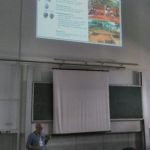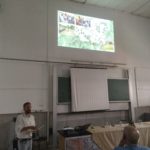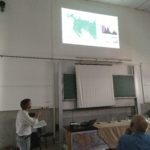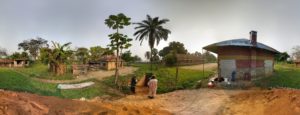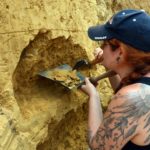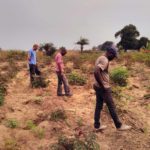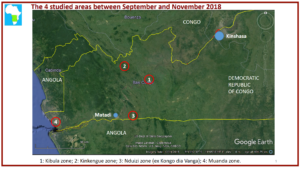
In close cooperation with the Institut des Musées Nationaux du Congo (IMNC), archaeological and paleo-environmental fieldwork was carried out from September 20 to November 24, 2018 in the Kongo-Central province of the DRC. The mission was carried out by Prof. Bernard Clist (mission leader, Ghent University), Clément Mambu Nsangathi (IMNC), Isidore Nkanu Nsasa (driver), and Suzanne Bigohe Mugisha (student from Kinshasa University).
The objectives of the mission were: (i) to gather more information from the Neolithic and Early Iron Age archaeological sites excavated in 1951, 1984 and 2015 by M. Bequaert, P. de Maret and B. Clist, respectively; (ii) to investigate possible ancient shell middens along the Atlantic Ocean coast and in the ‘Parc Marin des Mangroves’ along the Congolese banks of the Congo river; (iii) to carry out surveys to locate new sites to be excavated; (iv) to sample a maximum of ancient village pits to identify crops by carrying out flotations; and (v) to extract soil samples from as deep as possible to understand past vegetation changes. All of these objectives aim at a better understanding of the social and economic dynamics of the earliest villages settling the Kongo-Central province between the Atlantic coast and Kinshasa.
During the fieldwork period, we traveled 3,267 km, identified and documented 64 new archaeological sites dating from the Middle Stone Age to the Late Iron Age in the 4 selected study zones (Figure 1), and excavated 10 ancient hunter-gatherer, village and iron working sites. We were oriented to 4 sites by previous research (M. Bequaert, P. de Maret, B. Clist). However, new large-scale surveys around Kinkenge, Muanda and Nduizi (formerly Kongo dia Vanga) enabled us to excavate 6 new settlements. The surveys were strengthened by systematically interviewing farmers we met while walking through the fields and villages, after we showed them samples of broken pottery. These interviews sometimes led to the identification of promising sites, e.g. Muanda 6 on the coast.
Small scale archaeological excavations were carried out at Sakuzi (zone 1), Kindu and Mantsetsi (zone 2), Nduizi, Nguemba 1, Mbanza 2A, and Mbanza 2B (zone 3), and Boma1, Katala, Muanda 6, and Muanda 13 (zone 4). Soil sampling was conducted at the Kindu, Mantsetsi, Mbanza 2, and Muanda 6 sites, and pit sampling at the Kitala, Mbanza 2, Nduizi, Nguemba 1, and Sakuzi sites.
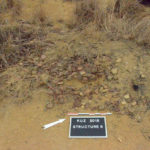
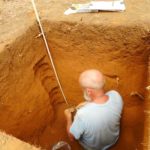
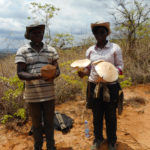
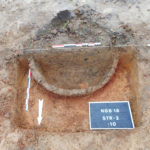
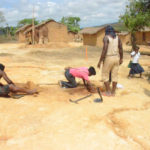
Stone Age: Very interesting data related to the Stone Age was collected at Boma 1. It consists mainly of quartz flakes, blades and cores found at -6.20 meters in a large borrow pit by the Boma-Muanda road. Stone artefacts, probably younger, were found stratified at Kindu and Mantsetsi down to -2 meters. Charcoals collected in situ, Carbon-13 (13C) analysis of soils, and the study of artefacts will give new insights on this epoch.
Neolithic and Ancient Iron Age: Most of the finds relate to this period due to the orientation of the BantuFirst project, roughly between 2,400 and 1,500 BP. Excavations at Kindu, Mantsetsi, Nduizi, and Sakuzi aimed at obtaining new data after prior excavations dating back to 1951 and 1984. Crucially, new pottery styles were identified in several pits at Nduizi and Sakuzi. Their study will certainly expand our preliminary understanding of the first villages to have settled the Kongo-Central Province.Apart from a poorly documented archaeological mission by the IMNC in 1986, we were the first to survey and excavate the area near the coast, west of Matadi, specifically between Boma and Muanda. At Muanda 6, systematic dry sieving yielded fish and small mammal bones associated to shell beads. Preliminary on-site analysis suggests that the Muanda style pottery is the oldest found in the lower level of Katala, at Muanda 6, and near the border to Cabinda at Muanda 8. It is followed by the Katala style of pottery found stratified under the present-day village and above the Muanda style level. We are now waiting for Carbon-14 (14C) dates to understand where the Muanda and Katala styles stand within the pottery cultural sequence of the Kongo-Central province.
Late Iron Age: The analysis of surface-collected pottery in the four surveyed areas will enable us to develop local cultural sequences. Such sequences will be informative in isolating interesting Ancient Iron Age sites to be excavated in 2019.
